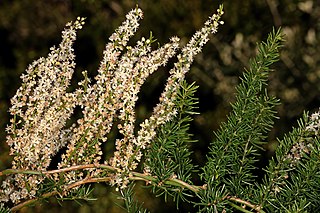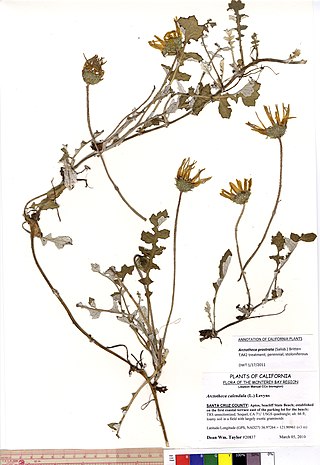
Lycopodium clavatum is the most widespread species in the genus Lycopodium in the clubmoss family.

Asparagus aethiopicus, Sprenger's asparagus, is a plant native to the Cape Provinces and the Northern Provinces of South Africa. Often used as an ornamental plant, it is considered an invasive weed in many locations. Asparagus fern, asparagus grass and foxtail fern are common names; however, it is unrelated to true ferns. A. aethiopicus has been confused with A. densiflorus, now regarded as a separate species, so that information about A. aethiopicus will often be found under the name A. densiflorus.

Ornithogalum umbellatum, the garden star-of-Bethlehem, grass lily, nap-at-noon, or eleven-o'clock lady, a species of the genus Ornithogalum, is a perennial bulbous flowering plant in the asparagus family (Asparagaceae). O. umbellatum is a relatively short plant, occurring in tufts of basal linear leaves, producing conspicuous white flowers, in a stellate pattern, in mid to late spring. The flowers open late in the day, but when closed have a green stripe on the outside. It is native throughout most of southern and central Europe, and north-western Africa. O. umbellatum is often grown as a garden ornamental, but in North America and other areas it has escaped cultivation and can be found in many areas, where it may become an invasive noxious weed. Parts of the plant are considered poisonous, but are used in some regional cuisines. Essences are also sold as patent remedies. O. umbellatum has been depicted in art by artists such as Leonardo da Vinci, and folklore has suggested it originally grew from fragments of the star of Bethlehem, hence its horticultural name.

Duvalia is a succulent plant genus in the subfamily Asclepiadoideae, in the family Apocynaceae (dogbane).

Dimorphotheca sinuata, the glandular Cape marigold, Namaqualand daisy, or orange Namaqualand daisy; syn. Dimorphotheca aurantiaca hort.) is a species of plants native to southern Africa. It is also widely cultivated as an ornamental and naturalized in parts of the United States, primarily California and Arizona.
Alatoseta is a genus of flowering plants in the family Asteraceae described as a genus in 1931.
Lepidostephium is a genus of South African flowering plants in the family Asteraceae. It is native to the Cape Provinces and KwaZulu-Natal.
Planea is a genus of flowering plants in the pussy's-toes tribe within the sunflower family. The only known species is Planea schlechteri, a rare and threatened species known from only a single population in Western Cape Province in South Africa.

Harpochloa is a genus of African plants in the grass family, common name caterpillar grass.

Dymondia is a genus of flowering plants in the family Asteraceae. There is only one known species, Dymondia margaretae, endemic to the Cape Province region of South Africa.
Hilliardia is a monotypic genus of South African flowering plants in the daisy family. It only contains one known species, Hilliardia zuurbergensis(Oliv.) B.Nord.

Stenostelma is a genus of plants in the family Apocynaceae, first described as a genus in 1894. It is native to South Africa.
- Stenostelma capenseSchltr. - Northern Cape Province
- Stenostelma carinatum(Schltr.) Bullock - KwaZulu-Natal
- Stenostelma corniculatum(E. Mey.) Bullock - Eastern Cape Province
- Stenostelma umbelluliferum(Schltr.) Bester & Nicholas - Gauteng Province

Stapeliopsis is a genus of succulent plants in the family Apocynaceae, native to southern Africa.
Aspidoglossum is a genus of plants in the family Apocynaceae, first described as a genus in 1838. It is native to Africa.

Piaranthus is a succulent plant genus in the subfamily Asclepiadoideae, in the family Apocynaceae.
Pectinaria is a genus of plants in the family Apocynaceae, first described as a genus in 1819. The entire genus is endemic to South Africa.
Capelio is a genus of flowering plant in the Asteraceae first described as a genus in 1836 with the name Alciope. It was renamed Capelio in 2002 after it was determined that the name Alciope was not legitimately published according to international nomenclatural rules. Capelio is a taxonomic anagram derived from the former name Alciope.

Arctotheca prostrata is a plant in the family Asteraceae native to Cape Province in South Africa. Common names include prostrate Cape weed and creeping bear's-ear. It is listed as an invasive weed in California and Australia.

Arctotis fastuosa, called Monarch-of-the-veld, is a species of African plants in the family Asteraceae, native to Namibia and South Africa. It has become naturalized on roadsides and in vacant urban lots in southern California.

Bidens bipinnata is a common and widespread species of flowering plant in the family Asteraceae.












